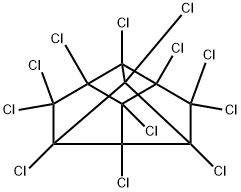Description
Mirex and chlordecone are two separate, but chemically similar, manufactured insecticides that do not occur naturally in the environment. Mirex is a white crystalline solid, and chlordecone is a tan-white crystalline solid. Both chemicals are odourless. Mirex and chlordecone have not been manufactured or used in the United States since 1978. Mirex was used to control fire ants and as a flame retardant in plastics, rubber, paint, paper, and electrical goods from 1959 to 1972. Chlordecone was used as an insecticide on tobacco, ornamental shrubs, bananas, and citrus trees and in ant and roach traps. Mirex was sold as a flame retardant under the trade name Dechlorane, and chlordecone was also known as Kepone. Mirex and chlordecone break down slowly in the environment, and they may stay for years in soil and water. Mirex is not readily decomposed chemically or biologically and is relatively persistent.
Chemical Properties
White Solid
Chemical Properties
Mirex is a snow-white crystalline solid.
Uses
An insecticide for fire ants. Formerly used as a fire retardant for plastics, rubber, paint, paper, electric goods. Reasonably anticipated to be a human carcinogen.
Uses
Formerly as fire retardant for plastics, rubber, paint, paper, electrical goods; insecticide for fire ants.
Definition
ChEBI: Mirex is an organochlorine insecticide and a chlorocarbon. It has a role as a persistent organic pollutant.
General Description
Odorless white crystalline solid.
Air & Water Reactions
Insoluble in water.
Reactivity Profile
MIREX is sensitive to exposure to sunlight. MIREX may react with strong oxidizers. MIREX reacts with lithium and tertiary butyl alcohol.
Hazard
Nephrotoxic, highly toxic, possible car-cinogen, teratogen, tumorigen, mutagen, poi-sonous, environmentally persistent, and bioaccu-mulates.
Health Hazard
INGESTION, INHALATION, OR SKIN EXPOSURE: Gas- trointestinal irritation with nausea, vomiting, and possible diarrhea. Malaise, headache, CNS excitation with tremor, paresthesias, ataxia, confusion, convulsions, and ventricular fibrillation. CNS depression and central respiratory paralysis may occur.
Health Hazard
Highly toxic by ingestion and moderatelytoxic by absorption through skin and inhalation; the toxic symptoms include tremor,ataxia, muscle spasms, and kidney and liverdamage; a teratogenic substance causingadverse reproductive effects; adequate evidence of carcinogenicity in experimentalanimals and a probable human carcinogen(IARC 1996)
LD50 oral (rat): 235 mg/kg
LD50 oral (hamster): 125 mg/kg
LD50 skin (rabbit): 800 mg/kg.
Fire Hazard
Behavior in Fire: Supports combustion
Safety Profile
Confirmed carcinogen
with experimental carcinogenic,
tumorigenic, and teratogenic data. Poison by
ingestion. Moderately toxic by inhalation
and skin contact. An experimental teratogen.Experimental reproductive effects. Mutation
data reported. A persistent insecticide that is
toxic to non-target species. It can
bioaccumulate
Potential Exposure
A potential danger to those involved
in the manufacture, formulation, and application of the
insecticide (particularly effective against fire ants). Also
used as a fire retardant in plastics. Not produced in the
United States but may be found in imported products.
First aid
If this chemical gets into the eyes, remove anycontact lenses at once and irrigate immediately for at least15 min, occasionally lifting upper and lower lids. Seek medical attention immediately. If this chemical contacts theskin, remove contaminated clothing and wash immediatelywith soap and water. Speed in removing material from skinis of extreme importance. Seek medical attention immediately. If this chemical has been inhaled, remove from exposure, begin rescue breathing (using universal precautions,including resuscitation mask) if breathing has stopped andCPR if heart action has stopped. Transfer promptly to amedical facility. When this chemical has been swallowed,get medical attention. Give large quantities of water andinduce vomiting. Do not make an unconscious personvomit.Note to physician: Gastric lavage or catharsis may be useful. High urine organic chlorine is indicative of exposurebut not of severity.
Carcinogenicity
Mirex is reasonably anticipated to be a human carcinogen based on sufficient evidence of carcinogenicity from studies in experimental
animals.
storage
Color Code—Blue: Health Hazard/Poison: Storein a secure poison location. Prior to working with thischemical you should be trained on its proper handling andstorage. Store in a cool area in closed containers awayfrom oxidizers and dichromates. A regulated, marked areashould be established where this chemical is handled,used, or stored in compliance with OSHA Standard1910.1045.
Shipping
UN2761 Organochlorine pesticides, solid, toxic,
Hazard Class: 6.1; Labels: 6.1-Poisonous materials.
Incompatibilities
Incompatible with oxidizers (chlorates,
nitrates, peroxides, permanganates, perchlorates, chlorine,
bromine, fluorine, etc.); contact may cause fires or explosions.
Keep away from alkaline materials, strong bases,
strong acids, oxoacids, epoxides, dichromates.
Waste Disposal
High-temperature incineration
is recommended. In accordance with 40CFR165, follow recommendations for the disposal of pesticides and pesticide
containers. Must be disposed properly by following
package label directions or by contacting your local or federal
environmental control agency, or by contacting your
regional EPA office.



